Let me kick off the Epimedium 2013 topic here in January, by highlighting some nursery sources. Choice Epimedium are becoming more available, and prices are starting to come down (although depends on where you shop). I have started the following list, please feel free to add links to additional nursery resources, indicating where the nursery is located.
Epimedium resources
Garden Vision Epimediums - Massachusetts, USA
"The Source" for extensive offering of accurately named Epimedium, including many of their own offerings by Epimedium guru Darrell Probst, now operated by Karen Perkins proprietor. No true interactive website other than an old photo gallery at: http://home.earthlink.net/~darrellpro/
Contact Karen Perkins at [email protected] and request a catalog, instead of using the contact link on the photo gallery page. In May there vare two "open nursery weekends", not to be missed.
Free Spirit Nursery - British Columbia, Canada
Epimedium introductions, 'Atlas', 'Spring Hearts', 'Spring Chocolate'
http://www.freespiritnursery.ca/plantintros.html
Thimble Farms Nursery - British Columbia, Canada, they do ship to the US.
Excellent affordable list of Epimedium, including the new 'Atlas' from Free Spirit Nursury.
http://www.thimblefarms.com/perennials%20a-g.html
Lazy S'S Farm - Virginia, USA
Pretty good listing of Epimedium, some choice items and good pricing
http://www.lazyssfarm.com/Plants/Perennials/E_files/E.htm
Collector's Nursery - Washington, USA
Very good listing of Epimedium, many of their own hybrids, fair prices.
http://www.collectorsnursery.com/cat03/index.php?main_page=index&cPath=2...
Plant Delights Nursery - North Carolina, USA
Very good listing of Epimedium, many of their own hybrids, prices on the high side.
http://www.plantdelights.com/E/products/825/2/0
It should be noted, that on some of the nursery lists I have looked at, there are a few misnomers/mis-IDs, where the photo does not match the species or cultivar. Be sure to research to make sure you're getting the right thing.

Comments
Mark McDonough
Re: Epimedium 2013
Thu, 05/23/2013 - 6:11pmI don't think I underrate the influence of the sun. But you are correct in that I'm focused on New England, of course because that's where I live and garden, so the notes I offer will have the most meaning for people in the same general area, or areas that might have some equivalency. We've had a very long and cool spring too, but I imagine that it'll be soon enough we'll get the full affront of HEAT, with our notorious heat-wave days that can last for weeks with temps reaching near 98-100 F (~37 C).
I did have the opportunity to garden in a drastically different climate, 3000 miles away in the Pacific Northwest, near Seattle Washington. I was struck by how different the climate was, 3 full USDA zones milder, yet plants were very much "softened" by the mild climate and abundant rain, then when a day that came along in summer that reached 84 F (29 C), an average day in New England, in this Seattle garden everything melted, drooped, and burned. A total eye-opener. So I do understand the difference.
My main point is, Epimediums realize their full potential in terms of best growth, best flowering and foliage coloration, with sufficient light. They will survive, prosper, and flower well enough, even in deep shade... amazing plants.
Toole (not verified)
Re: Epimedium 2013
Fri, 05/24/2013 - 1:55amTim/Mark/Gerrit.
Sorry for the delay --I'm just back from a long trip into Central Otago staying overnight after giving a presentation to a local garden group in Wanaka.
Decided i didn't have room in the cab of the truck for all my camera gear as well as the projector and laptop and plants etc etc .
Of course what happens ,first stop was about an hour up the road at a friends place where i saw for the first time a stunning clump of Narcissus viridiflorus growing and flowering in a sand bed...damn it, would have loved to have been able to take a pic..... :'( :'( :'( However it gives me confidence that if i ever manage to obtain a bulb I might be able to grow it down here at this end of the Island.Seed attempts over the years have been a complete failure.
I'll keep you briefed on the success or otherwise of the small E.versicolor rhizome over winter and beyond --it is now reasonably anchored in to the soil and obviously growing so all systems are go for the time being .... :)
Hello Gerrit
In very very simple terms importation into NZ is possible for plants on our Biosecurity list where they are approved for entry. (There are certain conditions to be meet and they can varying according to each Genera), however the administration costs with ,risk assessments, quarantine, pre/inspections overseas etc etc make it so prohibitive.
I had a quick look at the Epis on the list and see there are about 20 named.
Thankfully seeds of those on the list are allowed in if they are clean and packets fully labelled.
So yip fresh seed is the way to go that's for sure.
Cheers Dave.
(Moderator edit to enable quote)
gerrit (not verified)
Re: Epimedium 2013
Fri, 05/24/2013 - 3:26amWell Dave, all I can say, feel free contacting me. I'll be glad helping.
Gerrit.
gerrit (not verified)
Re: Epimedium 2013
Fri, 05/24/2013 - 8:17amA sunbeam suddenly hit a bud of Epimedium wushanense 'Caramel', who is beginning to bloom.
2 pictures of Epimedium grandiflorum 'Yellow Princess'.
Mark McDonough
Re: Epimedium 2013
Fri, 05/24/2013 - 9:18amGerrit, we're on such a similar track, I had gone out in the rain this morning and photographed E. grandiflorum 'Yellow Princess'! Mine has only just started flowering, it's a known late blooming, being a high mountain form of grandiflorum.
I had bought E. "wushanense" 'Caramel' mail order this spring, and it came as a nice sizable plant that has been flowering ever since it arrived. The unique color blooms are generous with pollen, so I've been picking off blooms daily and using the pollen on other epis ;D
Notice that I put the name "wushanense" in double quotes, as it is generally regarded that this plant
is of hybrid origin anddoes not represent the species E. wushanense, I've heard this from the horse's mouth so to speak.(Update: upon further research I was incorrect thinking this was a hybrid, apparently 'Caramel' represents a wild selection in China, but the identify as wushanense was put into question when Darrell Probst returned to China and collected from the "type" location, the true E. wushanense has very compact dense clusters of bloom. So the question about what species 'Caramel' represents remains a mystery, unless someone has discovered the truth).
Now I can't wait until next year when these plants get bigger, along with the two plants of 'Amber Queen' that I bought.
gerrit (not verified)
Re: Epimedium 2013
Fri, 05/24/2013 - 10:10amThe unique colour of E. "wushanense" 'Caramel' is to be seen in the attachment.
Mark, I assume you are not the first person, trying to use this colour for hybridization. I have seen already a lot of hybrids with this amber colour. Even E. 'Amber Queen' is influenced by 'Caramel' as it is from flavum x 'Caramel'. Another amber colouring we can see more or less at E. x omeiense 'Stormcloud', a natural hybrid from Omei Mountain. Just the same we can observe at E. x omeiense 'Akame'. All have that unique colouring.
Mark, about the double quoting of "wushanense". I thought, an x would be sufficient to show it is a hybrid.
So Epimedium x wushanense 'Caramel'. I never heard this before.
Mark McDonough
Re: Epimedium 2013
Fri, 05/24/2013 - 10:47amGerrit, I made a correction and offered updated information on the 'Caramel' epimedium in my post above, in a different color. Here's a couple links that talk about this plant not being wushanense, both represent some communication with Darrell Probst. Next time I see Darrell, I'll ask about what species he thinks this 'Caramel' selection belongs to.
http://www.plantdelights.com/Epimedium-wushanense-Wushan-Fairy-Wings/pro...
(scroll down 6 message to a post by Geoforce, also notice our friend Tony Willis in this following discussion thread):
http://www.gardenbuddies.com/forum/messages/64189/1233900.html
By the way Gerrit, nice photo of 'Caramel', shows off the color well.
Mark McDonough
Re: Epimedium 2013
Fri, 05/24/2013 - 10:57amEpimedium seed pods are forming en masse!
View of my E. pubigerum hybrid, has lovely textured foliage and bright red leaf petioles. Very few of the flowers formed seed pods, although there are a couple.
Gerrit, I should add more comment about your 4 photos above of acuminatum & ilicifolium; again, very nice portraits of those plants. I can see how your planting on a small raised wall shows the flowers off to excellent effect. Your ilicifolium looks like it has brighter yellow flowers than mine, which are a decidedly pale yellow.
Toole (not verified)
Re: Epimedium 2013
Sat, 05/25/2013 - 2:48pmThat's very kind of you Gerrit.
I'll PM you.
Cheers Dave.
Lori S. (not verified)
Re: Epimedium 2013
Sat, 05/25/2013 - 9:14pmI'm impressed by the huge flowers (relative to other Epimedium I have) on these plants this spring -
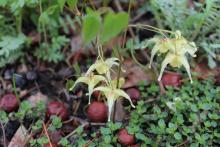
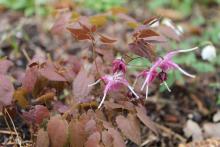
E. 'Harold Epstein' and E. grandiflorum 'Queen Esta':
I bought the first one as "E. grandiflorum v. koreanum" 'Harold Epstein'. Would it actually be E. grandiflorum f. flavescens 'Harold Epstein' then?
Mark McDonough
Re: Epimedium 2013
Sat, 05/25/2013 - 9:39pmLori, it seems like your repertoire of hardy Epimediums in Alberta is increasing! Yes, Harold Epstein should be written as E. grandiflorum f. flavescens 'Harold Epstein'. Is the selection of available Epimedium increasing in Canada, did you get your plants mail order? I'm really interested in knowing how hardy Epimedium species/cultivars will be in colder climates, colder than my USDA Zone 5. 'Queen Esta' is a nice one too, great for spring foliage color.
gerrit (not verified)
Re: Epimedium 2013
Sun, 05/26/2013 - 4:59amEpimedium mikinorii is another one at the end of the flowering season. Was not often to be seen here.
Difficult to take pictures. Each flower is looking its own different way. And they are hidden between the leaves. The flowers are down with a long outer whitish sepal, almost covering the inner pink petal. The end of the spur is heading up. The rather big leaves are typical spined.
The two last pictures show an overall display, with the amber coloring of E. wushanense 'Caramel'.
Maybe there is a fine hybridization between those two.
gerrit (not verified)
Re: Epimedium 2013
Mon, 05/27/2013 - 10:58amProbably the last flowering eppi of the season. But a real stunner. Extremely spiny flowers in red and copper tones. Top 5. Very small size and suitable for the rock garden.
Epimedium 'Spine Tingler'.
Trond Hoy
Re: Epimedium 2013
Tue, 05/28/2013 - 1:09amThis thread evolves fast! Can barely cope with the posts ;)
Thanks Mark. Make sense - I do remember the name when you tell me and not much has happened in this corner of the world regarding Epimediums for about 100 years.
Mark McDonough
Re: Epimedium 2013
Wed, 05/29/2013 - 5:29pmGerrit, 'Spine Tingler' is a wonderful plant, yet another one to add to my list of Epimedium to purchase.
Lis, your fiendishly spreading yellow Epimedium might be E. koreanum, does it have very large light-to-mid-green leaflets? Another yellow spreader (but much better behaved) is E. pinnatum ssp. colchicum or hybrids with it (E. x perralchicum 'Frohnleiten' or 'Wisley'). One thing I like about the Garden Vision Epimedium catalog by Karen Perkins, is that it identifies all Epimedium species and cultivars as to whether they are "clumpers" or "runners".
I love your catch phrase for Epimedium, "foliage with style", couldn't be more true.
Longma (not verified)
Re: Epimedium 2013
Mon, 06/03/2013 - 5:21amThe first time an Epimedium has flowered in our garden, ;D. Was sold to us recently as Epimedium x 'Merlin'. Looking forward to seeing many many more in the years to come.
Mark McDonough
Re: Epimedium 2013
Mon, 06/03/2013 - 5:45amCongratulations Ron on your first Epimedium flowering, there's no turning back now ;D It looks correct as 'Merlin', distinctive on account of the rounded inflated look to the cup. It's one of a couple dozen epimedium that I lost in our severe drought several years ago, need to replace this one.
Longma (not verified)
Re: Epimedium 2013
Mon, 06/03/2013 - 7:43amThanks Mark. We know that this will be the first of many, :rolleyes:
We have three others but no sign of flowering, and I suppose its getting late now isn't it? Something for next year?
Richard T. Rodich
Re: Epimedium 2013
Mon, 06/03/2013 - 7:32pmMy first epimedium was E. x rubrum. It still amazes me with its tenacity in the driest, shady places. You've got a start with a much nicer one, Ron.
Epimedium davidii with some spent petals strewn about. There are some impatiens seedlings among, and anyone care to guess what the other plant is?
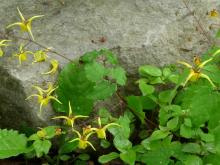
Epimedium lishihchenii
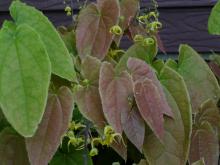
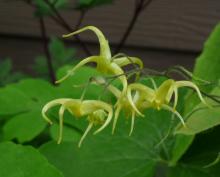
This one came from Chen Yi many years ago. For several years it barely survived, but it is now finally taking hold. She labeled it as E. platypetalum. New foliage is sometimes mottled, but quickly fades. The plant is very small, like Niveum, but the flowers are larger. Any ID ideas?
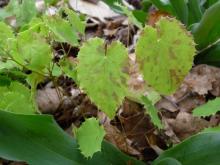
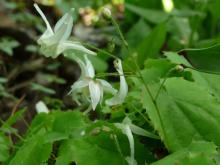
Epimedium stellulatum 'Wudang Star'
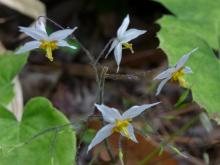
gerrit (not verified)
Re: Epimedium 2013
Mon, 06/03/2013 - 11:34pmRick, my guess is Epimedium pauciflorum. In my garden running and running and running but no flowers.
http://www.johnjearrard.co.uk/plants/epimedium/epimediumpauciflorum/spec...
But many of Chen Yi's plants are misnamed, so I'm not surprised. She also named many of her species as
'species 1' or 'species 9'.
My first Epimedium was also x rubrum. A very good one to start with. I'm still fond of it.
Mark McDonough
Re: Epimedium 2013
Mon, 06/03/2013 - 11:42pmOh, that was eerie, here I am up late in California, traveling for work, just typed in my ID to Rick's Chen Yi white epimedium, hit Post, and it said another message was just posted, and when I look at your message Gerrit, we say pretty much the same thing!
Here's what I had written:
===================
The Chen Yi white epimedium is a close fit for E. pauciflorum, definitely not the yellow-flowered spurless E. platypetalum. If it truly is E. pauciflorum, be aware that is a spreading species.
Epimedium x rubrum was my first Epimedium too, and a good one it is.
Richard T. Rodich
Re: Epimedium 2013
Tue, 06/04/2013 - 8:36pmHaHa! Well there certainly is a paucity of flowers. I had already notice the possible non-clumping nature of the plant, but it's still too small for me to make any judgements on my own. Great minds think alike.... Thanks for the info, guys!
Margaret Young
Re: Epimedium 2013
Wed, 06/05/2013 - 7:55amWe have found that new Epis take a year to settle to flower here in Aberdeen, so perhaps they'll do the same for you.
M
Longma (not verified)
Re: Epimedium 2013
Fri, 06/07/2013 - 11:45amWe're hoping that will hold good for the East Coast here also Maggi. So many beautiful Epimedium. Thanks for the information :)
gerrit (not verified)
Re: Epimedium 2013
Sat, 06/08/2013 - 10:16amSeveral years ago I bought this Epimedium. I planted it in a corner of my garden underneath a big conifer.
The years following, the plant suffered from neglection and drought. Eventually there was almost nothing left of it and I said to myself: Whether you rescue him or he'll die. And probably you'll never get a new one. So I replanted him to a better place. And today he rewarded me with new leaves and some flowers.
Epimedium shuichengense. Very mottled leaves, Davidii like inflorescence with long spurs and curious crumpled sepals. From American origin: Cc 030175. But obviously never seen in this pages.
Longma (not verified)
Re: Epimedium 2013
Sat, 06/08/2013 - 10:48amThat is a very beautiful species Gerrit, :o. You must be so pleased you decided to save it, 8)
This nursery site has some great pictures of Epimedium. In the picture gallery are a number of plants which may be 'new species'?
http://www.koenvanpoucke.be/english/index.asp
Mark McDonough
Re: Epimedium 2013
Sat, 06/08/2013 - 10:00pmWow Gerrit, that's a unique one. The "Cc" number indicates it is from Garden Vision, but I don't think it was ever offered in their catalog. How big is the flower, measuring from spur-tip across to the opposite spur-tip?
gerrit (not verified)
Re: Epimedium 2013
Sun, 06/09/2013 - 4:07amAs you can see 3cm. Yes it is a tiny species.
deesen (not verified)
Re: Epimedium 2013
Tue, 06/11/2013 - 4:58amMy first one too (aren't they the Devil's own job to photograph, well that's my excuse!). Bought as Epimedium excalcaratum OG 93082 and the label tells me it is evergreen. Can anyone offer me any clues as to what 'OG 93082 means please?
Mark McDonough
Re: Epimedium 2013
Tue, 06/11/2013 - 5:28amDavid, the "OG" number indicates an original collection by Japanese botanist Mikinori Ogisu, for which two species are commemorative names honoring this individual, Epimedium ogisui and E. mikinorii. In total he introduced 15 species of Epimedium. Of those he introduced, one is E. ecalcaratum (note spelling), collected in Western Sichuan as number OG 93082. This information from Stearn's The Genus Epimedium.
Can't really see the flower detail in your photos, to tell if there are vestigial spur bumps or "shoulders" to the petals, but since it has the OG number, one can probably assume it is correct.
deesen (not verified)
Re: Epimedium 2013
Tue, 06/11/2013 - 11:13amMany thanks for that Mark and thanks for the spelling correction too. When you get to my age the 25 metres from the plants position to the kitchen where my notepad resides do tend to play havoc with what are left of my memory cells! ;D
We are promised rain all day tomorrow so I will try to get a reasonable pic of the flower details as soon as possible. I bought the plant a couple of weeks ago from Keith Wiley. Not sure how widely known outside the UK Keith is but he has a very individual planting style in his garden which has attracted a lot of attention over the years. If anyone knows of his work and is interested I could post some pics of my recent garden visit.
Richard T. Rodich
A testament of Epimedium
Sun, 06/23/2013 - 8:06pmA testament of Epimedium hardiness.: this 3 year seedling survives in the cement stoop crack, facing south in full sun. In zone 4, snow is cleared away there, all winter long. Parents could be E. x youngianum and/or E. diphyllum. Yet these established plants in the garden to the side of the stoop have died (or are just hanging on) following this winter.
Yet another experience that supports the need for dry winters to survive extreme cold.
Toole (not verified)
Hello Gerrit
Tue, 06/25/2013 - 2:11amHello Gerrit
I've tried sending you a PM today however it won't go through and i get a message " has disabled private message receiving".
Cheers Dave.
Mark McDonough
Toole wrote:
Tue, 06/25/2013 - 7:51am[quote=Toole]
Hello Gerrit
I've tried sending you a PM today however it won't go through and i get a message " has disabled private message receiving".
Cheers Dave.
[/quote]
Dave, one item at the top of the list to be fixed here on this new version of NARGS Forum, is to get a direct link to one's pm InBox (most people can't even find their inbox here, a direct link is missing), and to enable some level of PM notification. Hopefully this shortcoming will get straightened out by the web master.
Toole (not verified)
Thanks Mark for that info
Tue, 06/25/2013 - 5:49pmThanks Mark for that info ,Gerrit has made contact.
Cheers Dave.
Pages